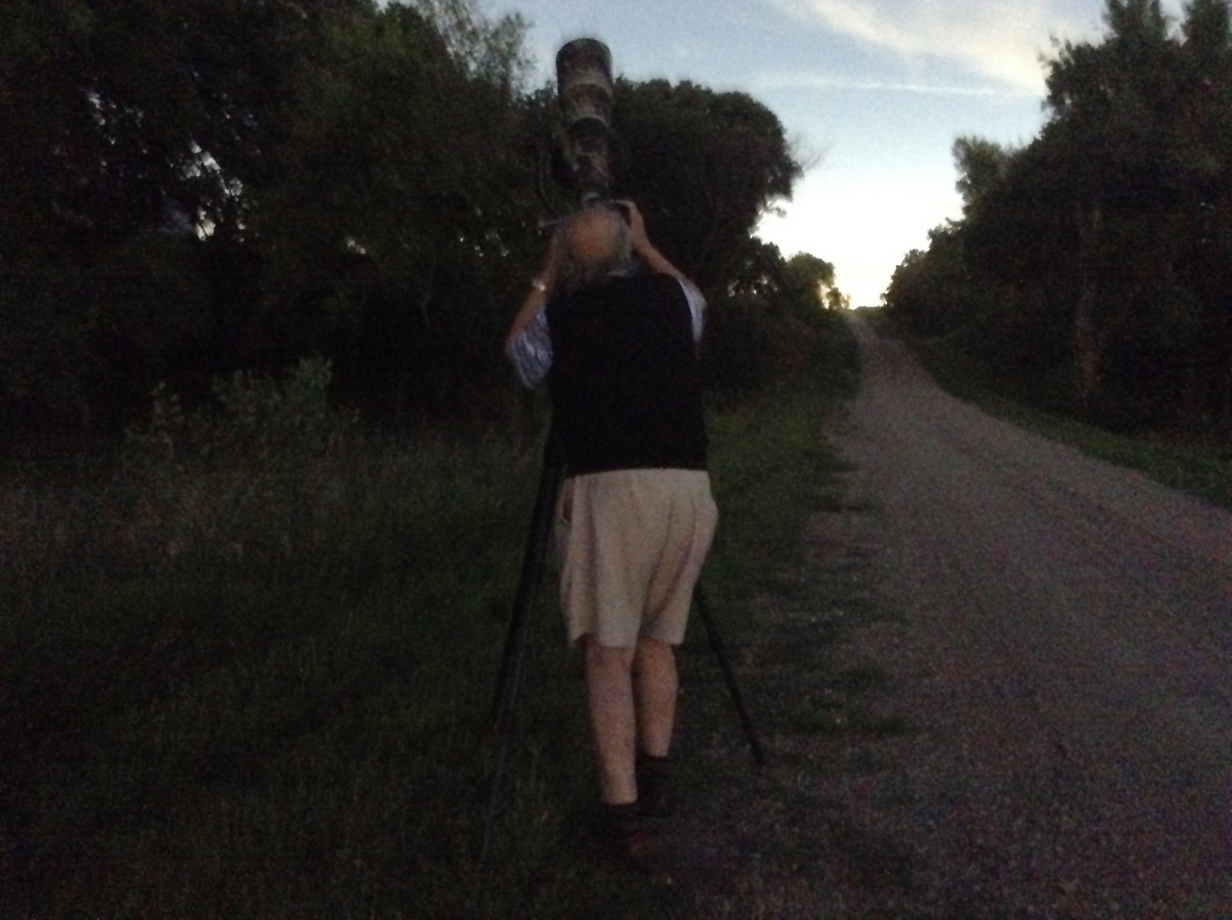Total Solar Eclipse of August 21, 2017
We were spectacularly lucky with the weather and saw the eclipse in a perfect sky. Forecasts were for mostly cloudy weather, and we had to dodge high cirrus by driving along southern Nebraska's Highway 2 between Hazard and Litchfield, just north of Kearney. Our hotel in Kearney had about 1 minute 58 seconds of totality, but we managed to drive along essentially the center of the Moon's shadow path to a clear place where totality lasted 2.5 minutes. Shortly before totality, the last cirrus clouds drifted by. During totality and for about 20 minutes before and afterward, it was completely clear.
We found an ideal spot on a tiny side-road south of Hwy 2, looking over a forest (for good seeing) and with no other people in sight. The eclipse was spectacular. To me, the most impressive aspect was that this drama happened (of course) in complete silence. In this age of pervasive noise and explosive Hollywood movies and TV, the contrast between the spectacle and the silence made an unforgettable impression.
This was our second total eclipse of the Sun. We saw our first one on July 11, 1991, from the Big Island of Hawaii. There, clouds were thick enough during totality so that we saw only solar prominences and the innermost part of the corona -- much less spectacular than what we saw in 2017. What was impressive in 1991 from our vantage point on the westward-facing slopes of Hualalai volcano was the clear view of the dark shadow of the Moon zooming toward us over the ocean at more than 1000 miles per hour. We could not see this effect in 2017.
This web site shows our pictures of the 2017 eclipse. The eclipsed Sun was imaged with an 800 mm telephoto lens (the first two pictures that show the corona) augmented to 1600 mm focal length (the last picture that shows prominences).
The pictures are copyrighted and should not be used for commercial purposes without permission. They can be used for astronomy class lectures without asking me for permission.

Here, I am pointing the camera a few minutes before totality, so that I don't have to waste time looking for the Sun while it is eclipsed. The camera is stopped down to a pinhole aperture with a piece of cardboard.

Mary took this picture about 10 minutes before totality with her ipad. Even a few seconds before totality, the thin crescent of the Sun is overwhelmingly bright to the naked eye. But here, we accidentally got a much fainter ghost image that is almost well exposed and that shows the thin crescent. Because it is a ghost image on the other side of the center of the image from the overexposed Sun, the ghost is rotated by 180 degrees from what we saw (the bright part of the Sun is toward upper-right, opposite to lower-left as we saw it).

Mary took this picture of the sky and horizon during totality. Note that the sky is dark above us but fairly bright around the horizon, where we see out beyond the edge of the Moon's shadow. This can also be seen in the next picture.

Taking pictures of the eclipsed Sun with the telephoto lens at f/5.6 full aperture

This most nearly shows what we saw with the naked eye. In an almost-dark sky, the pearly glow of the corona surrounding the absolutely black, perfect circle of the Moon was very dramatic. The world around us had gone silent. Even the birds stopped chirping.
This asymmetric corona is characteristic of the Sun at sunspot minimum.

A shorter exposure better shows structure in the corona. The magnetic poles of the Sun are where the almost radial bright streaks become most radial (upper-left and lower-right).

This picture taken at 1600 mm and f/11 has enough magnification to show prominences on the side of the Moon where the Sun is emerging. On the other side, the Sun's image is small enough so that prominences are covered by the Moon. Totality ended a few seconds before this picture was taken.

A few minutes after totality ended, like just before totality, the world looked very surreal -- much more so than this picture shows. Here, the scene around us is fully sunlit, so there are deep shadows. But it is almost dark, as in deep twilight. Clouds rarely make it this dark, and when they do, the dominant color is bluer and there are no shadows. Similarly, in twilight, the Sun has set and there are no deep shadows. But when I took this picture, the combination of normal daylight color, deep shadows, and a low light level looked very strange. Of course, the camera completely compensates by increasing the exposure time. So this picture looks entirely normal. It shows Mary with our camera at the quiet, private site where we were priviledged to see the eclipse.
John Kormendy Home Page
University of Texas Astronomy Home Page
Last update: August 29, 2017. Total visits since Tuesday, August 29, 2017 =
John Kormendy (kormendy@astro.as.utexas.edu)